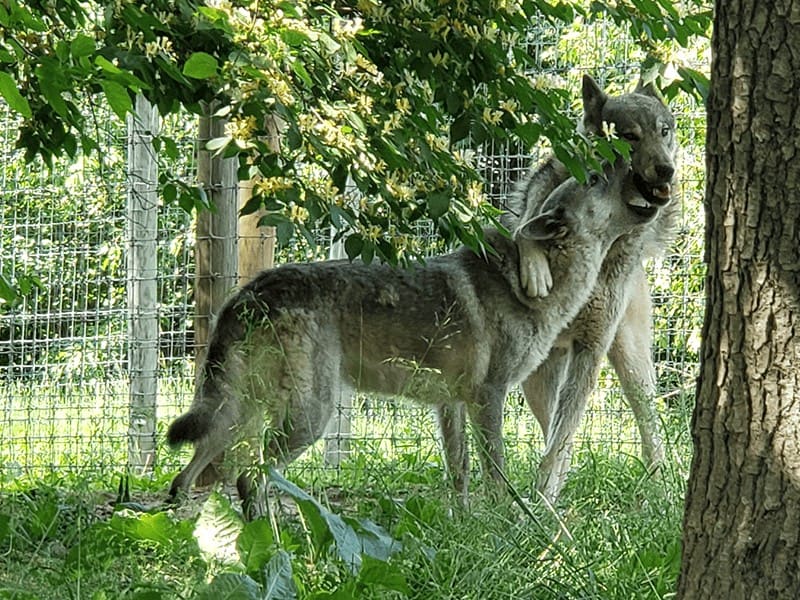Wolf Nation (2017) Sounds a Powerful Howl for An Iconic American Mammal
Americans have always had a complicated relationship with wolves. They’ve seen them either as noble animals whom they should respect and appreciate or as vicious monsters who terrify both people and other animals. They’ve hunted wolves for centuries and eliminated them in large swathes of their original ranges, but they’ve also advocated for protecting them and reintroducing them to their original habitats.
Wolves have long inspired curiosity, hatred, hostility, love, and competing desires to both attack and defend them. No matter which way people look at them, they play a major role in the United States’ ecosystems, history, and culture. Nature writer Brenda Peterson’s book Wolf Nation (2017) dives into the science, history, and recovery of wild wolves to show how important these canines are to the United States.
The Ways of Wolves
In Wolf Nation (2017), Brenda Peterson provides great insights into the biology and ecology of wild wolves. She discusses how wolf packs in the wild are families, with the dominant pair of wolves being the parents, their older children being responsible for protecting the pack, and the pups being the next generation. She explains how wolves are social animals that prefer to live in packs and that lone wolves are rather rare.
Peterson describes why wolves howl: a wolf’s howl can be used to identify itself to other wolves, call their pack together for a hunt, defend their territory from unfamiliar wolves, and mourn pack members who passed away. She also explains how wolf pups play to learn how to stalk, hunt, and establish social hierarchies in the pack. She notes how wolves tend to take more risks than dogs do and how their risk-taking has allowed wolves to evolve and change.
In one particularly interesting chapter, Peterson discusses trophic cascades and shows how the presence or absence of wolves in an ecosystem affects that ecosystem’s health. Where wolves have been reintroduced to their natural habitats, the ecosystem is much healthier because wolves keep prey populations in check, prevent overgrazing of plant life, and enhance the diversity of plant and animal life; where wolves have been removed from their natural habitats, prey populations grow out of control, plants are overgrazed, and plants and animals suffer. The concept of trophic cascades speak to the vital ecological niches wolves fill in their natural habitats.
Hunting and Eliminating Wolves
Peterson chronicles and criticizes the long history of Americans fearing, hating, and hunting wolves. She describes how hunters and ranchers are usually very hostile towards protecting and reintroducing wolves to their original natural habitats since they view wolves as threats to game animals, livestock, pets, and humans. Farming and hunting interests play outsized roles in convincing government agencies to allow wolves to be hunted and their protections to be curtailed.
Many state governments give major leeway to hunters and ranchers to exterminate wolves whether or not wolves actually attacked livestock or humans; many have also curtailed endangered species protections for wolves in their states. The federal government used to aggressively cull wolves, then added the wolf to the Endangered Species List in 1978 and helped reintroduce wolves to some of their native habitats in the 1990s, and then removed gray wolves from the list in 2020. While some governors, senators, and federal agents have fought for more protection for wolves, many times their successors have fought to weaken or remove those measures.
Peterson notes how even though a majority of Americans support wolf recovery on public lands, ranchers, hunters, and state government officials have all posed major barriers to wolf reintroduction. She makes the reader feel the frustration of wolf advocates having to fight incredible odds to secure protections for wolves and the tragedy of thousands of wolves being killed every year due to the hostility of state governments and private hunters.
Protecting and Reintroducing Wolves
Despite the hostilities hunters, farmers, and government officials often express towards wolves, Peterson shows that people can change from wolf haters to wolf defenders. She illustrates this point through the stories of Ernest Thompson Seton and Aldo Leopold, two men hired by the federal government to hunt wolves. After they hunted and killed remarkable wolves that evaded capture for so long and showed deep sorrow for their lost packmates, Thompson and Leopold both saw the errors of their ways, learned to appreciate the value of wolves, and became strong advocates for wolves and wildlife protection.
Compared to older generations mostly set in their ways, young children and teenagers Peterson’s met and taught about wolves view wolves more positively and are more enthusiastic about wolf conservation and reintroduction. Peterson explains how telling the individual stories of wolves like OR-7, who traveled across several western states in search of a new mate after his family was killed, and showing positive depictions of wolves in media can overcome old and inaccurate stereotypes of wolves as solitary, aggressive, and hateful killers.
Peterson discusses the successful reintroductions of Rocky Mountain wolves to Yellowstone National Park and Mexican wolves to the Blue Ridge Wilderness area of Arizona and New Mexico. She explains how reintroduction has helped these ecosystems recover from the trophic cascades caused by the absence of wolves and how wolf watchers, scientists, and conservationists have learned much more about wolf biology and behavior through observing wild wolf packs.
Final Thoughts
Throughout Wolf Nation, Brenda Peterson makes a compelling argument about how important the “wolf nation” is to not only the United States’ ecosystems but also its people and cultural identity. She explains how changes in human attitudes towards wolves, from fear and hostility to understanding and support, have been monumentally important to helping bring wolves back into the wild. She also emphasizes how necessary wolves are to making the world “wild and whole again.”
Wolf Nation is one of the most comprehensive books ever written about the wild wolves that live in the United States. If you want to learn about the important roles wolves play in their natural ecosystems, the complicated relationships between wolves and humans, the removal of wolves from their natural habitats, and the ongoing process of recovering wolf populations in their former ranges, this book is an absolute must-read.
For More Great Content
Total Apex is an all-encompassing content producer. We provide heavily detailed articles every day on entertainment, gaming, sports, and so much more! For more exemplary gaming and entertainment content, read our daily content on these sites: Total Apex Gaming and Total Apex Entertainment.



